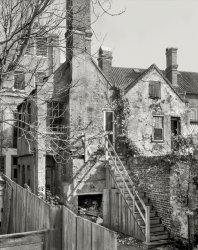
MAY CONTAIN NUTS

Search Shorpy
SHORPY ART

Framed or unframed, desk size to sofa size, printed by us in Arizona and Alabama since 2007. Explore now.
Join and Share
Ad-Free Shorpy
Shorpy is funded by you. Patreon contributors get an ad-free experience.
Learn more.

Recent comments
- Button It Up
- And with an eye on the time ...
- Working in an enclosed ashtray
- Rear View Mirror?
- Tobacco cam
- Basic fact I learned only later in life
- Put a Lid on it!
- Pinstripes in the Tower
- Sound enhancement
- 3438 in '38
- Second Career
- Their days are numbered
- Only the Sensor
- Train control mechanism
- Rarest of the Rare?? & Classy 3400 Class
- Control Mechanism
- Those standpipes
- Wrenches
- International D-40 I believe
- Job prospects
- You had me at Train
- Land of the free
- Broad-Exchange Bldg
- Parking innovation
- The old block
- "Peck turned a sweet propeller"
- National Bank Building
- Notch shot
- Straight ahead (right, left, left, right)
- Ship lifespans
Member Photos
The Shorpy
Printporium
Printporium
Search Shorpy
Search results -- 30 results per page
- Gray Acres: 1937
- October 1937. "Family of Joe Kramer, farmer near Williston, North Dakota." Photo by ... Posted by Dave - 08/27/2013 - 3:36pm -
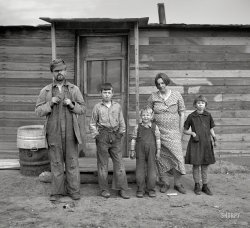
- Leaning Out: 1937
- August 1937. "Abandoned store building and old sidewalk on what was the main street. ... Posted by Dave - 11/14/2015 - 3:39pm -
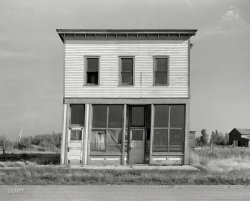
- My Left Foot: 1937
- September 1937. "Camp near Effie, Minnesota. Lumberjack washing his feet." Medium format ... Posted by Dave - 03/07/2010 - 3:08am -
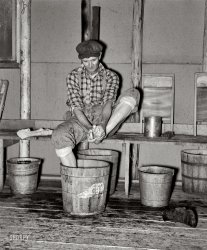
- Badlands: 1937
- September 1937. "Old threshing machine on Herman Gerling's farm near Wheelock, North ... Posted by Dave - 02/24/2018 - 5:50pm -
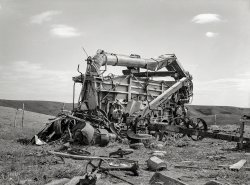
- Hanging Out: 1937
- New Orleans circa 1937. "1133-1135 Chartres Street." Laundry day in the Quarter. 8x10 inch ... Posted by Dave - 07/19/2012 - 4:36pm -
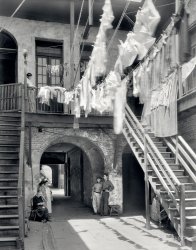
- Crossing Guard: 1937
- San Francisco, 1937. "Don Lee Oldsmobile on Golden Gate Bridge with police officer." Whose ... Posted by Dave - 05/04/2015 - 8:16am -
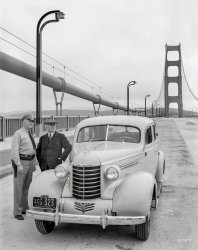
- Trick or Treat: 1937
- 1937. Rowan County, N.C. "Maxwell Chambers house, Spencer vicinity. Structure ... Posted by Dave - 08/09/2012 - 1:20pm -
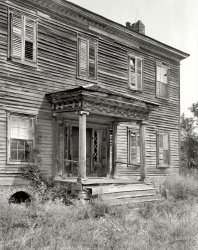
- Inner Sanctum: 1937
- New Orleans, 1937. "Courtyard entrance, 1133-1135 Chartres St." Seen here from another ... Posted by Dave - 06/29/2013 - 12:54pm -
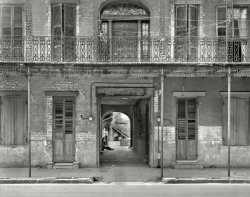
- Park Here: 1937
- July 1937. "Parking lot in Washington, D.C." Medium-format negative by Russell Lee ... got built on narrow right-of-way lots. Too bad there's no 1937 Street View to click on and see what the facade looked like.
Roadster ... Posted by Dave - 01/03/2015 - 10:03pm -
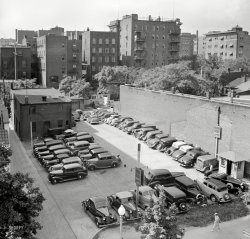
- Happy, Happy: 1937
- 1937. Washington, D.C. "Elder Michaux, Happy News Cafe." The radio evangelist ... Posted by Dave - 09/12/2011 - 7:21pm -
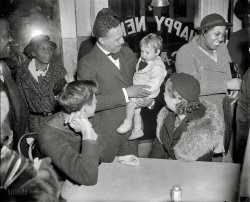
- On Walden Pond: 1937
- September 1937. Concord, Massachusetts. "At Walden Pond, haunt of Thoreau." View full ... Posted by Dave - 06/14/2008 - 11:31am -
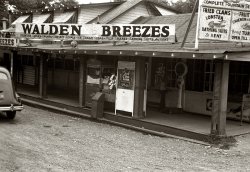
- Winter Haven: 1937
- January 1937. Family of a migratory fruit worker from Tennessee, camped in a field near ... Posted by Dave - 09/09/2011 - 11:38am -
![Winter Haven: 1937 January 1937. Family of a migratory fruit worker from Tennessee, camped in a field near a citrus packer at Winter Haven, Florida. View full size. 35mm nitrate negative by Arthur Rothstein for the Farm Security Administration.
Baby With Scissors!Not exactly the most kid-friendly toy! I love the look of the little girl on the right. The rest seem so intense.
Two Families?This looks like two related families--the women in the dark dress looks as old as the one in the light dress and the kids sort of divide up by hair color. Maybe a sister-in-law?
Migratory CampersThe family looks to be neat, the clothes (what we can see of them) don't seem to be shabby and even the car (again, what we can see of it) almost shines. They don't appear to be the usual down and out migrant workers. The scissors wielder may be the family barber. Is there more to this story?
[More of them here. And here. - Dave]
My thoughts exactlyTheir expressions are so intense, as though they are seeing another human for the first time ever. Inquisitive and guarded.
More LikelyI think it's more likely that the "woman" in the dark dress (holding her hand to her face) is probably the eldest daughter of the family. I'd guess that like the other kids she's standing on the running board of the car. There's no real indication that she's even advanced into puberty (or if she had, is very far down that road). Remember in the days of teenage marriage, when "effective" birth control, particularly for the rural poor, consisted primarily of the rhythm method, coitus interruptus, and prayer, they had them early and often.
(The Gallery, Arthur Rothstein, Cars, Trucks, Buses, Kids)](https://www.shorpy.com/files/images/8a08231u_0.thumbnail.jpg)
- A Million Newsstand Readers: 1937
- ... in Washington, D.C. Photograph by John Vachon, November, 1937. View full size.
Hungry Children? I'm sitting here looking at ... seem like they say "I'm hungry!" I hope not but it is 1937.
A million newsstand readers.... but how many buying?
Ewww… ... Posted by Ken - 09/08/2011 - 8:38pm -
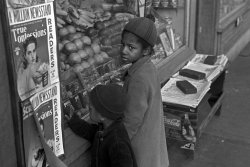
- Character Study: 1937
- January 1937. Ottawa, Illinois. "Two types living along the waterfront." Photo by ... Posted by Dave - 05/30/2013 - 7:09am -
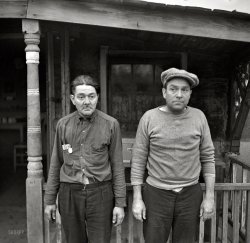
- Don't Go There: 1937
- April 1937. Shawneetown, Illinois. "An old residence near the levee after the flood." ... they were able to save it....
High water mark? that 1937 Ohio River Flood was a doozy, as the flotsam scattered about gives ... Posted by Dave - 10/25/2015 - 2:20pm -
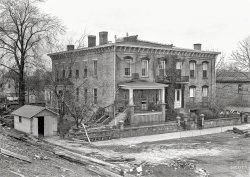
- Strike Lounge: 1937
- January 1937. Flint, Michigan. "Sit-down strikers. Fisher Body plant No. 3." The labor ... Posted by Dave - 04/17/2019 - 1:19pm -
![Strike Lounge: 1937 January 1937. Flint, Michigan. "Sit-down strikers. Fisher Body plant No. 3." The labor action that led to the unionization of the American auto industry. Note the "sleeping car" at right. Photo by Sheldon Dick. View full size.
One for the history books, literallyMy U.S. History class in high school used this image when discussing the changes in labor laws in the early 20th century. Cool to see it again!
Home decor requisitesI simply must get a blanket rope and ashtray installed on the back of my sofa!
Spiffy bunchLove the relaxing accommodations... bench seats all around! But saddle shoes and brogans on the assembly line -- what's up with that? Seems nobody's really expecting the work to get too hard or too dirty, strike notwithstanding.
Now I knowwhy my Uncles 1936 car came with no back seat.
Fisher 3?I believe that this terrific photo was made inside Fisher 1 on Saginaw Street. Flint had two Fisher Body plants, Fisher 1 and 2. Most of the strike activities in Flint took place at Fisher 1 and 2 with strikes also taking place at Cleveland, KC and Atlanta.
Music to strike byI believe that is a gramaphone between the table abd the Tic Tac Tow car. Not to mentiion a large stack of platters on the table.
[It's a radio-phonograph console. -tterrace]
(The Gallery, Cars, Trucks, Buses, Factories, Sheldon Dick)](https://www.shorpy.com/files/images/SHORPY_8c28669a.thumbnail.jpg)
- A Fresh Start: 1937
- Washington, D.C., 1937. "Baby's bath" is all it says here. If you recognize yourself 78 years ... Posted by Dave - 07/02/2015 - 10:50am -
![A Fresh Start: 1937 Washington, D.C., 1937. "Baby's bath" is all it says here. If you recognize yourself 78 years later, let us know. Harris & Ewing glass negative. View full size.
Bassinettes and BathinettesThis is a bathinette. The flat top can be seen hanging behind. That made it a changing table. Some had a ruler printed on the top so baby's growth could be documented. A bassinette was usually made of woven wood with folding legs and wheels. A skirt made of nylon net was de rigueur. So babies got their own furniture plus daily laundry ... belly bands, tar soap, boric acid, cradle cap, rubber pants, diaper pins, hard-soled shoes.. sterilized bottles, pablum ? I sure feel old!
No, I don't recognize himBut I do notice two other things: 1) the photographer did not accurately focus on his/her subject, but it was probably close enough for whatever purpose this image served prior to being posted on the internet at hi-res for me to criticize, and 2) what's up with the elaborate (and flimsy) baby bath setup?!? Just put the kid in the tub you already have back there, already! I suppose the idea was to bring the kid closer to Mom, and to use less water. But for me it would still be just an unnecessarily complicated and wobbly piece of junk to take up space in the bathroom.
[Even if you are unfamiliar with the multipurpose item of baby furniture known as the bassinet, you probably got yourself changed on one. - Dave]
Babies and BathwaterSure hope the kid is still with us, as opposed to those unfortunates that went down the drain.
BathinetteMy aunt had one of these strange things. You toted the water in a bucket, and drained it out with a hose in the bottom. It might have been mainly a "first child" thing. I know my mother bathed my sisters in a basin or a sink, and I think my aunt did after the first kid. You could close the lid and use it as a changing table.
A disclaimer, perhaps?Dave, can you please zoom in on that label below the handle on the bassinet?
["???MOR MANUFACTURING CORP." -tterrace]
Where does the water comes out from?Anyone noticed the washbasin does not have a faucet - just three knobs?
[Presumably it's the "integral spout" type similar to this. -tterrace]
The Bathinette CompanyMy mother had one in the early 1950s. I don't know if she had one for me a decade earlier.
It was made by the Bathinette Company. It was the best way for her to give my baby brother a bath and then flip the top up and powder and diaper him. It had a handy drain hose and I was fascinated with the way it folded up for storage. (I was easily amazed back then)
(The Gallery, D.C., Harris + Ewing, Kids)](https://www.shorpy.com/files/images/SHORPY-23313a.thumbnail.jpg)
- One Flight Up: 1937
- May 7, 1937. "William Goldberg, 771 Broadway, Manhattan." 8x10 gelatin silver print by ... Posted by Dave - 01/06/2016 - 10:04am -
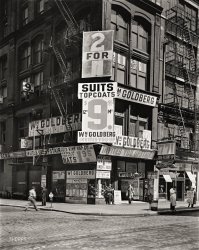
- The Lumberjack Way: 1937
- September 1937. "Cooks drying 'silverware' in logging camp near Effie, Minnesota." Medium ... Posted by Dave - 02/23/2018 - 10:22am -
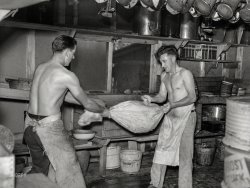
- Walker Evans: 1937
- The photographer Walker Evans in a February 1937 portrait by his colleague Edwin Locke. 35mm negative, Farm Security ... Posted by Dave - 12/28/2007 - 12:26am -
![Walker Evans: 1937 The photographer Walker Evans in a February 1937 portrait by his colleague Edwin Locke. 35mm negative, Farm Security Administration. View full size.
Pow!This is a stunning, powerful, portrait! Have to order a copy immediately!
[Order received. Thanks. - Dave]
IndeedWell Johnny you truly are correct, an amazing photo, what wonderful emotions.
(The Gallery, Edwin Locke, Portraits, Walker Evans)](https://www.shorpy.com/files/images/8a14702u.thumbnail.jpg)
- Pavement Ends: 1937
- March 1937. "Wind erosion has desolated this once luxuriant bunch grass country in ... Posted by Dave - 06/28/2013 - 9:26am -

- Clark's Corner: 1937
- January 1937. Brevard County, Florida. "Roadstand near Cocoa." Photo by Arthur ... Posted by Dave - 02/13/2014 - 5:47pm -
![Clark's Corner: 1937 January 1937. Brevard County, Florida. "Roadstand near Cocoa." Photo by Arthur Rothstein for the Farm Security Administration. View full size.
Cocoa Beach!Just wait another thirty years, give or take. A bottle will wash up on the shore, to be discovered by an astronaut on a training exercise.
[No bottles will be washing up in Cocoa, which is on the Indian River and about 8 miles from Cocoa Beach and the Atlantic Ocean. - Ken]
Pop. 120As described in Florida: A Guide to the Southernmost State (Federal Writers' Project, 1939):
"INDIAN RIVER CITY, 50.9m (19 alt., 120 pop.) formerly called Clark's Corner, consists of a few stucco houses, filling stations, and a post office, overlooking the broad reaches of the river. Indian River City is at the junction with State 22 (see Tour 9).
South of Indian River City dense growths of palms and pines flank U.S. 1; palmetto thickets and low green shrubbery add to the beauty of the water views."
In Color!Corner of (now) SR50 and US1. Postcard from the State Archives of Florida, (Florida Memory).
I HAD to look it upa TEMPLE is a bright orange red colored fruit, oval shaped, easy to peel and a cross between an orange and a tangerine, it has lots of seeds and a bitter orange flesh under the skin.
TitusvilleThis stand was about 20 minutes away from Cocoa and 30 miles from Cocoa Beach. The corner is in Titusville (I live within walking distance of it). Indian River City was consolidated with Titusville back in the 60's. Today if you look across that river you can see Kennedy Space Center. There is nothing left of the buildings in the post card. It's now a busy intersection with a Walgreens and a gas station.
The temple orangeThe temple orange originated in Winter Park Florida, developed by Louis Hakes and named after W. C. Temple, both residents of Winter Park. There's a Temple Drive and Temple Trail in Winter Park, the latter leading into the neighborhood in which I grew up.
(The Gallery, Arthur Rothstein, Eateries & Bars, Florida, Stores & Markets)](https://www.shorpy.com/files/images/SHORPY_8b28486a.thumbnail.jpg)
- Nanty Glo Slag Pickers: 1937
- ... coal from the slag heaps at Nanty Glo, Pennsylvania. 1937. They get 10 cents for each hundred-pound sack. View full size. Photo ... Posted by Dave - 09/08/2011 - 11:31am -
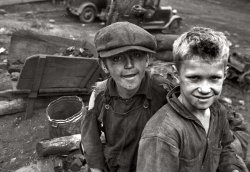
- Little Cousin: 1937
- August 1937. "Indian girl and her baby cousin. Blueberry pickers' camp, Littlefork, ... Posted by Dave - 03/02/2010 - 1:40pm -
![Little Cousin: 1937 August 1937. "Indian girl and her baby cousin. Blueberry pickers' camp, Littlefork, Minnesota." Medium format nitrate negative by Russell Lee for the Resettlement Administration. View full size.
Contrasting ViewsShe is quite pretty; he is not amused. Excellent!
Looks likesomeone I once knew.
Not a Happy CamperMaybe it's the shoes?
Another wonderful shot by Russell LeeWith the late afternoon sun lighting up their faces, you can clearly see how much the girl cares for her young niece. Yet another Russell Lee photograph that qualifies as "art" in my book! Thanks, Dave.
[Cousin, not niece. And the kid is a boy. - Dave]
Making a livingThese two Ojibwe (Chippewa) were most likely from nearby Bois Forte Indian Reservation near Nett Lake in Koochiching County, Minnesota. Wild blueberry picking was one of few sources of income for the Chippewa at that time. My family provided guiding to out-of-area fishermen and hunters for a living in addition to picking wild blueberries during that period for which buyers would pay 10 cents a pound. The little guy in this photo is probably expressing what I remember mostly of those times out in the bush picking berries, it always seemed to be hot, lots of annoying bugs all day long.
Baby boy?I seem to have missed something. How do we know that the baby is a boy. "Indian girl and her baby cousin. Blueberry pickers' camp, Littlefork, Minnesota." Was there more to the photo notation than what was posted?
[Caption information for the other photos of these two note that the child is a boy. - Dave]
(The Gallery, Kids, Russell Lee)](https://www.shorpy.com/files/images/8b36862u.thumbnail.jpg)
- Maryland Junk: 1937
- October 1937. "Houses near the railroad tracks. Hagerstown, Maryland." Our title comes ... Posted by Dave - 11/01/2017 - 10:54am -
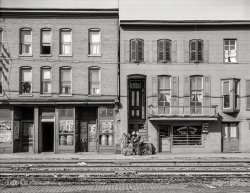
- Lock the Car: 1937
- July 1937. "Georgia road sign." Photo by Dorothea Lange, who seems to have ... Posted by Dave - 02/08/2014 - 11:06pm -
![Lock the Car: 1937 July 1937. "Georgia road sign." Photo by Dorothea Lange, who seems to have appreciated quirky signs. More to come later in the week. View full size.
SignThe owner of that sign should sue McDonald's.
[For want of an "r" the suit was lost. -tterrace]
LOL?I'm not sure if "LOL" counts as a real comment on here, but, I did.
Georgia needs sign spell-checkThis reminds me of a sign I saw in Georgia while driving from Columbus to Augusta back in the early '70s: "PLAM READER." Her clairvoyant powers didn't extend to spelling, it seems.
Loose DefinitionHambuglars
n.
Cockney expression
Amateur Cornetist
Ex: Irving Berlin song, "Someday I'm going to murder the Buglar".
Trichinosis anyone?All the right ingredients!
(The Gallery, Dorothea Lange, Eateries & Bars)](https://www.shorpy.com/files/images/SHORPY_8b32263a.thumbnail.jpg)
- Winter Palace: 1937
- December 1937. "House in disrepair. Abandoned farm community. Dalton, Allegany County, ... Posted by Dave - 12/03/2017 - 4:55pm -
![Winter Palace: 1937 December 1937. "House in disrepair. Abandoned farm community. Dalton, Allegany County, New York." Photo by Arthur Rothstein. View full size.
Beautiful DisasterIt would be lovely to see a picture of what the house looked like in its prime. As my father would say, it looks like it's got "good bones." I don't envy the person who had to clean all those windows, though. That was an all-day affair.
Shifting SandsDid something move?
The house, to me, gives the appearance of being built on a beach, especially given the wrap-around porches. And there is no beach in that area.
And, according to my map, Dalton is not in Allegany County but rather Livingston County.
[Dalton addresses include locations in Allegany County. - Dave]
Winter SandIn the Northeast we call it "snow."
Oops.Closer examination reveals my mistaken identification of sand is actually snow.
Please excuse my mistake. We here in Houston very rarely get snow. The most abundant natural element we get is water, and more water and ...
[Another clue would be the title of the post. - Dave]
White as sand versus as snow I too thought sand and dunes when I first saw this photograph. But just now, when I went for a closer look at how the building was put together, the white is snow. Suddenly it's a lot colder out.
Building went from charming derelict to abandoned ruin in my mind.
No ThanksI would suggest that the last owner realized the old place needed a complete paint job and justly decided to simply walk away.
First a right, then a left, then an uppercutOh man, you guys are rough on poor Sandy, I mean Randy! An understandable mistake from a distance without clicking the photo for a closer look. However, another clue might be that "sand" drifting around the edges of the upper floor balcony. All in good fun Randy, each of us gets a turn over Dave's barrel.
(The Gallery, Agriculture, Arthur Rothstein)](https://www.shorpy.com/files/images/SHORPY-8b37801a.thumbnail.jpg)
- Truckin: 1937
- Washington, D.C., circa 1937. "Repairing government trucks at the Treasury procurement section." Harris ... Posted by Dave - 08/15/2012 - 12:10pm -
![Truckin: 1937 Washington, D.C., circa 1937. "Repairing government trucks at the Treasury procurement section." Harris & Ewing Collection glass negative. View full size.
Carb QueryIs it possible to get a close up of the carburetor? There a word stamped on it, and I can't quite read it.
[It's a Carter carburetor. Or "Carbureter," as the company spelled it. - Dave]
Stylin'Cool socks.
StraightforwardDon't you just love the simplicity of that engine? Pre-regulation power and performance -- and yes, pre-regulation pollution -- but it didn't take a rocket surgeon to keep one running either.
VentedI noticed that they are both wearing the same types of shoes with vent holes in the side.
Procurers of ...What do you think the Treasury was procuring there in the "fuel yard," way back yonder? Nudge, nudge, wink wink, say no more.
By the way, it's easy to see here the origin of the term "well-heeled," which is what these guys were not, even if their shoes were Buicks.
(The Gallery, Cars, Trucks, Buses, D.C., Harris + Ewing)](https://www.shorpy.com/files/images/23267a.thumbnail.jpg)
- Commuter Parking: 1937
- November 1937. "School at Greenbelt, Maryland." Notable for being an early planned ... Posted by Dave - 08/13/2013 - 3:38pm -
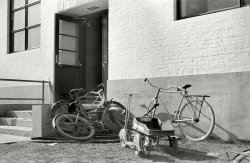
- Rear Windows: 1937
- 1937. "Legges House (rear), 101 East Bay Street, Charleston, South Carolina." ... the second floor was the "summer kitchen" at least in 1937 when the picture was taken, but given what appears to be an old fireplace ... Posted by Dave - 06/13/2017 - 5:58pm -
